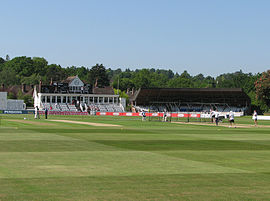Nevill Ground

The pavilion of the Nevill Ground
|
|||||
| Ground information | |||||
|---|---|---|---|---|---|
| Location | Royal Tunbridge Wells, Kent, England | ||||
| Coordinates | 51°07′20″N 0°16′05″E / 51.12222°N 0.26806°ECoordinates: 51°07′20″N 0°16′05″E / 51.12222°N 0.26806°E | ||||
| Establishment | 1898 | ||||
| Capacity | 6,000 | ||||
| Owner | Tunbridge Wells Borough Council | ||||
| End names | |||||
| Pavilion End Railway End |
|||||
| International information | |||||
| Only ODI | 18 June 1983: |
||||
| Team information | |||||
|
|||||
| As of 15 December 2007 Source: CricketArchive |
|||||
The Nevill Ground is a cricket venue located in Royal Tunbridge Wells, Kent, England. It is owned by Tunbridge Wells Borough Council and is used by Tunbridge Wells Cricket Club as well as annually for Tunbridge Wells Cricket Week by Kent County Cricket Club. It was opened in 1898 and was first used by Kent in 1901 and has been used by them annually since then, despite a suffragette arson attack that destroyed the pavilion in 1913.
It played host to one One Day International during the 1983 Cricket World Cup, the group stage match between India and Zimbabwe in which Kapil Dev made a score of 175 not out. The Nevill Ground is known for having rhododendron bushes around the perimeter.
The Nevill Ground was established in 1895 after the purchase of the land by the Tunbridge Wells Cricket, Football and Athletic Club, with assistance from the Bluemantle Cricket Club. It was purchased on a 99-year lease from the Marquess of Abergavenny as the land was part of his Eridge Park estate. The Nevill Ground was named after William Nevill, 1st Marquess of Abergavenny. Building of the ground's facilities started in 1896 with it being officially opened by the Marquess of Abergavenny in 1898. In the early 20th century, the county boundary between Kent and East Sussex ran through the Nevill Ground's pitch. Rhododendron bushes were also planted in the Nevill Ground's early history. The rhododendrons around the pitch are considered by cricket commentators as one of the defining images of the Nevill Ground. The end opposite the pavilion is known as the Railway End due to the Hastings Line running close by that end of the ground.
...
Wikipedia
